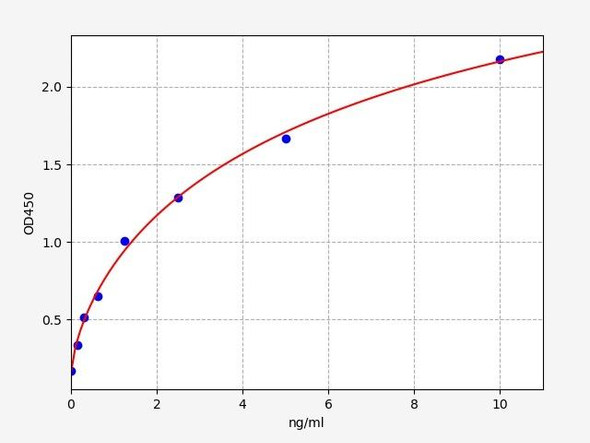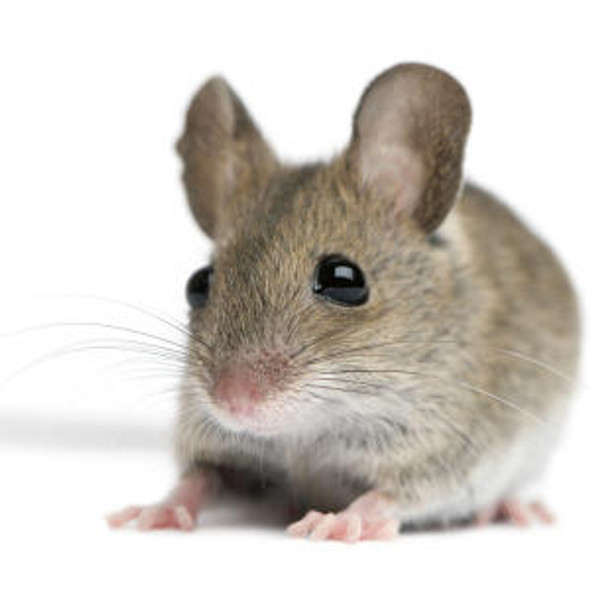Mouse Metabolism ELISA Kits
Mouse 5-LO (Arachidonate 5-Lipoxygenase) CLIA Kit (MOES00605)
- SKU:
- MOES00605
- Product Type:
- ELISA Kit
- ELISA Type:
- CLIA Kit
- Size:
- 96 Assays
- Sensitivity:
- 18.75pg/mL
- Range:
- 31.25-2000pg/mL
- ELISA Type:
- Sandwich
- Synonyms:
- ALOX5, 5-LOX, LOX5, 5LPG, LOG5
- Reactivity:
- Mouse
- Sample Type:
- Serum, plasma and other biological fluids
- Research Area:
- Metabolism
Description
| Assay type: | Sandwich |
| Format: | 96T |
| Assay time: | 4.5h |
| Reactivity: | Mouse |
| Detection method: | Chemiluminescence |
| Detection range: | 31.25-2000 pg/mL |
| Sensitivity: | 18.75 pg/mL |
| Sample volume: | 100µL |
| Sample type: | Tissue homogenates,cell lysates and other biological fluids |
| Repeatability: | CV < 15% |
| Specificity: | This kit recognizes Mouse 5-LO in samples. No significant cross-reactivity or interference between Mouse 5-LO and analogues was observed. |
This kit uses Sandwich-CLIA as the method. The micro CLIA plate provided in this kit has been pre-coated with an antibody specific to Mouse 5-LO. Standards or samples are added to the appropriate micro CLIA plate wells and combined with the specific antibody. Then a biotinylated detection antibody specific for Mouse 5-LO and Avidin-Horseradish Peroxidase (HRP) conjugate are added to each micro plate well successively and incubated. Free components are washed away. The substrate solution is added to each well. Only those wells that contain Mouse 5-LO, biotinylated detection antibody and Avidin-HRP conjugate will appear fluorescence. The Relative light unit (RLU) value is measured spectrophotometrically by the Chemiluminescence immunoassay analyzer. The RLU value is positively associated with the concentration of Mouse 5-LO. The concentration of Mouse 5-LO in the samples can be calculated by comparing the RLU of the samples to the standard curve.
| UniProt Protein Function: | 5-LO: arachidonate 5-lipoxygenase. Arachidonic acid promotes its phosphorylation by p38 MAPK-regulated MAPKAP kinases. Upregulated in glioblastoma multiforme and colon, pancreatic and bladder cancer. |
| UniProt Protein Details: | Protein type:Lipid Metabolism - arachidonic acid; Nuclear envelope; Oxidoreductase; Lipid Metabolism - linoleic acid; EC 1. 13. 11. 34 Chromosomal Location of Human Ortholog: 10q11. 2 Cellular Component: extracellular space; nuclear membrane; nuclear matrix; nuclear envelope lumen; nuclear envelope; cytosol Molecular Function:protein binding; iron ion binding; arachidonate 5-lipoxygenase activity Biological Process: leukotriene biosynthetic process; leukotriene production during acute inflammatory response; lipoxygenase pathway; arachidonic acid metabolic process; leukotriene metabolic process Disease: Asthma, Susceptibility To |
| NCBI Summary: | This gene encodes a member of the lipoxygenase gene family and plays a dual role in the synthesis of leukotrienes from arachidonic acid. The encoded protein, which is expressed specifically in bone marrow-derived cells, catalyzes the conversion of arachidonic acid to 5(S)-hydroperoxy-6-trans-8,11,14-cis-eicosatetraenoic acid, and further to the allylic epoxide 5(S)-trans-7,9-trans-11,14-cis-eicosatetrenoic acid (leukotriene A4). Leukotrienes are important mediators of a number of inflammatory and allergic conditions. Mutations in the promoter region of this gene lead to a diminished response to antileukotriene drugs used in the treatment of asthma and may also be associated with atherosclerosis and several cancers. Alternatively spliced transcript variants encoding different isoforms have been found for this gene. [provided by RefSeq, Jan 2012] |
| UniProt Code: | P48999 |
| NCBI GenInfo Identifier: | 4502057 |
| NCBI Gene ID: | 240 |
| NCBI Accession: | NP_000689. 1 |
| UniProt Secondary Accession: | P48999,P48999, P12527, |
| UniProt Related Accession: | P09917 |
| Molecular Weight: | |
| NCBI Full Name: | arachidonate 5-lipoxygenase isoform 1 |
| NCBI Synonym Full Names: | arachidonate 5-lipoxygenase |
| NCBI Official Symbol: | ALOX5 |
| NCBI Official Synonym Symbols: | 5-LO; 5LPG; LOG5; 5-LOX |
| NCBI Protein Information: | arachidonate 5-lipoxygenase |
| UniProt Protein Name: | Arachidonate 5-lipoxygenase |
| UniProt Gene Name: | ALOX5 |
| UniProt Entry Name: | LOX5_HUMAN |
As the RLU values of the standard curve may vary according to the conditions of the actual assay performance (e. g. operator, pipetting technique, washing technique or temperature effects), the operator should establish a standard curve for each test. Typical standard curve and data is provided below for reference only.
| Concentration (pg/mL) | RLU | Average | Corrected |
| 2000 | 53782 57660 | 55721 | 55693 |
| 1000 | 23113 24835 | 23974 | 23946 |
| 500 | 11408 10656 | 11032 | 11004 |
| 250 | 5072 5516 | 5294 | 5266 |
| 125 | 2648 2568 | 2608 | 2580 |
| 62.5 | 1368 1254 | 1311 | 1283 |
| 31.25 | 631 717 | 674 | 646 |
| 0 | 27 29 | 28 | -- |
Precision
Intra-assay Precision (Precision within an assay): 3 samples with low, mid range and high level Mouse 5-LO were tested 20 times on one plate, respectively.
Inter-assay Precision (Precision between assays): 3 samples with low, mid range and high level Mouse 5-LO were tested on 3 different plates, 20 replicates in each plate.
| Intra-assay Precision | Inter-assay Precision | |||||
| Sample | 1 | 2 | 3 | 1 | 2 | 3 |
| n | 20 | 20 | 20 | 20 | 20 | 20 |
| Mean (pg/mL) | 105.25 | 310.32 | 873.25 | 95.24 | 338.73 | 822.02 |
| Standard deviation | 10.37 | 34.20 | 86.98 | 10.95 | 23.98 | 71.35 |
| C V (%) | 9.85 | 11.02 | 9.96 | 11.50 | 7.08 | 8.68 |
Recovery
The recovery of Mouse 5-LO spiked at three different levels in samples throughout the range of the assay was evaluated in various matrices.
| Sample Type | Range (%) | Average Recovery (%) |
| Serum (n=5) | 94-106 | 99 |
| EDTA plasma (n=5) | 85-97 | 92 |
| Cell culture media (n=5) | 90-104 | 95 |
Linearity
Samples were spiked with high concentrations of Mouse 5-LO and diluted with Reference Standard & Sample Diluent to produce samples with values within the range of the assay.
| Serum (n=5) | EDTA plasma (n=5) | Cell culture media (n=5) | ||
| 1:2 | Range (%) | 98-113 | 88-101 | 98-115 |
| Average (%) | 105 | 95 | 105 | |
| 1:4 | Range (%) | 95-111 | 101-118 | 96-111 |
| Average (%) | 102 | 108 | 102 | |
| 1:8 | Range (%) | 93-107 | 96-108 | 84-99 |
| Average (%) | 100 | 103 | 91 | |
| 1:16 | Range (%) | 91-104 | 97-114 | 102-118 |
| Average (%) | 96 | 105 | 108 |
An unopened kit can be stored at 4°C for 1 month. If the kit is not used within 1 month, store the items separately according to the following conditions once the kit is received.
| Item | Specifications | Storage |
| Micro CLIA Plate(Dismountable) | 8 wells ×12 strips | -20°C, 6 months |
| Reference Standard | 2 vials | |
| Concentrated Biotinylated Detection Ab (100×) | 1 vial, 120 µL | |
| Concentrated HRP Conjugate (100×) | 1 vial, 120 µL | -20°C(shading light), 6 months |
| Reference Standard & Sample Diluent | 1 vial, 20 mL | 4°C, 6 months |
| Biotinylated Detection Ab Diluent | 1 vial, 14 mL | |
| HRP Conjugate Diluent | 1 vial, 14 mL | |
| Concentrated Wash Buffer (25×) | 1 vial, 30 mL | |
| Substrate Reagent A | 1 vial, 5 mL | 4°C (shading light) |
| Substrate Reagent B | 1 vial, 5 mL | 4°C (shading light) |
| Plate Sealer | 5 pieces | |
| Product Description | 1 copy | |
| Certificate of Analysis | 1 copy |
- Set standard, test sample and control (zero) wells on the pre-coated plate and record theirpositions. It is recommended to measure each standard and sample in duplicate. Note: addall solutions to the bottom of the plate wells while avoiding contact with the well walls. Ensuresolutions do not foam when adding to the wells.
- Aliquot 100µl of standard solutions into the standard wells.
- Add 100µl of Sample / Standard dilution buffer into the control (zero) well.
- Add 100µl of properly diluted sample (serum, plasma, tissue homogenates and otherbiological fluids. ) into test sample wells.
- Cover the plate with the sealer provided in the kit and incubate for 90 min at 37°C.
- Aspirate the liquid from each well, do not wash. Immediately add 100µL of BiotinylatedDetection Ab working solution to each well. Cover the plate with a plate seal and gently mix. Incubate for 1 hour at 37°C.
- Aspirate or decant the solution from the plate and add 350µL of wash buffer to each welland incubate for 1-2 minutes at room temperature. Aspirate the solution from each well andclap the plate on absorbent filter paper to dry. Repeat this process 3 times. Note: a microplatewasher can be used in this step and other wash steps.
- Add 100µL of HRP Conjugate working solution to each well. Cover with a plate seal andincubate for 30 min at 37°C.
- Aspirate or decant the solution from each well. Repeat the wash process for five times asconducted in step 7.
- Add 100µL of Substrate mixture solution to each well. Cover with a new plate seal andincubate for no more than 5 min at 37°C. Protect the plate from light.
- Determine the RLU value of each well immediately.






